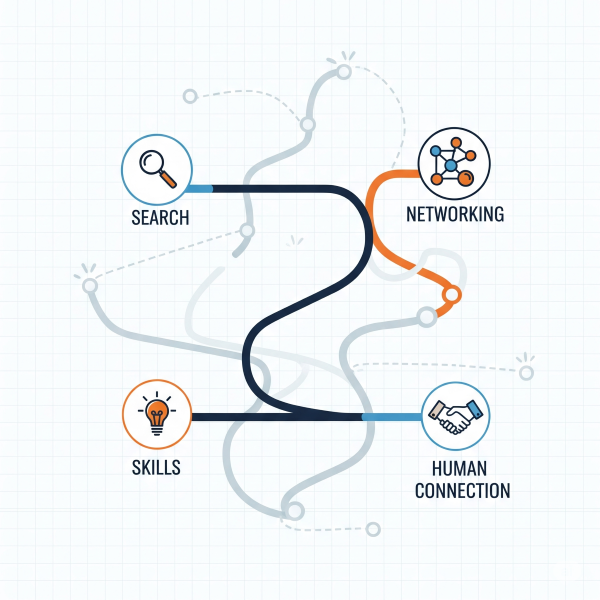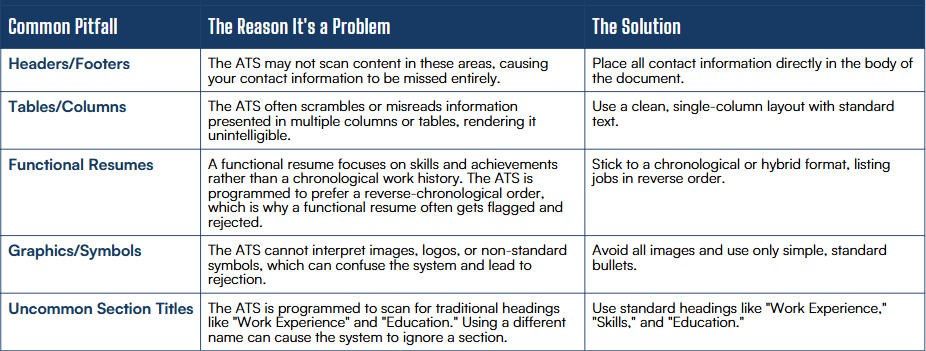
The Modern Job Search Toolkit: A Skills-First Guide for All Functions
The game has changed. Learn how to beat the bots, leverage a skills-first mindset, and tap into the hidden job market with our guide to a modern job search.
The hiring landscape is a new game, and if you’re using old rules, you're not going to win. The good news? The challenges we've discussed are entirely surmountable with a multi-faceted and proactive strategy. The path to re-engagement requires mastering the systems, showcasing a new value proposition, and strategically bypassing the flawed digital landscape entirely.
The ATS and Beyond: Optimizing Your Digital Footprint
The first step in a modern job search is to ensure your resume can successfully navigate the automated gauntlet of an Applicant Tracking System (ATS). The goal is to make your resume easy for a machine to parse and a human to understand.
Your strategy must focus on both content and formatting. For content, the priority is to use keywords that are an exact match to the job description. This isn't just about listing skills; it involves weaving them into your resume summary and work history in natural, contextual sentences. It's also crucial to use both the full term and the acronym for important keywords (e.g., "Enterprise Resource Planning (ERP)") to ensure the resume is recognized by search algorithms.
On the formatting front, simplicity is key. Avoid complex visual elements that can scramble information, such as headers, tables, text boxes, and graphics. Stick to standard fonts like Arial, Calibri, or Garamond and use simple, consistent bullet points.

The New Value Proposition: Embracing a Skills-First Mindset
The most effective way to counter the resume filtering of an ATS is to move from a value proposition based on years of tenure to one centered on demonstrable skills. The trend is clear: a 2025 Indeed report found that more than half (51%) of hiring managers believe on-the-job experience and skills are more important than degrees or job titles.
This trend is a direct opportunity for experienced professionals to reframe their careers. The first step is to create a "transferable skills inventory" that moves beyond a simple list of past job responsibilities. For those considering a career change, a project portfolio is a powerful tool to provide tangible evidence of your abilities. It demonstrates how you can solve real-world problems and connects your past experience to a new field.
To maintain a competitive edge, continuous learning is not an option but a necessity. Your digital presence, particularly on LinkedIn, must reflect this. An effective LinkedIn headline should highlight your technical expertise, industry focus, and quantifiable impact.
The Path Forward: Accessing the Hidden Job Market
The most powerful strategy is to circumvent the automated systems entirely and tap into the "hidden job market"—the vast number of jobs that are never publicly advertised. The key to accessing these unlisted opportunities is a proactive approach focused on building genuine, lasting relationships with human decision-makers.
Networking is the cornerstone of this strategy. It’s not about swapping business cards; it's about positioning yourself as a key player in your field by contributing to industry forums, writing articles, and actively engaging on platforms like LinkedIn.
The "cold pitch" is a direct way to express interest in a company or role that may not be on the public radar. The key to an effective pitch is personalization. It should mention a recent project, a shared connection, or a specific business challenge to demonstrate genuine interest. These strategic interactions allow you to present a nuanced and compelling value proposition that cannot be captured by an ATS-optimized resume. The most successful professionals will use a dual strategy: mastering the digital systems to get through when necessary, while simultaneously bypassing them to make direct, human-to-human connections.
The challenges are clear. The solutions are now in your hands. But what does it look like to put these strategies into action? In our final blog post, we'll show you exactly how our team navigates these barriers and connects you directly with the right roles.